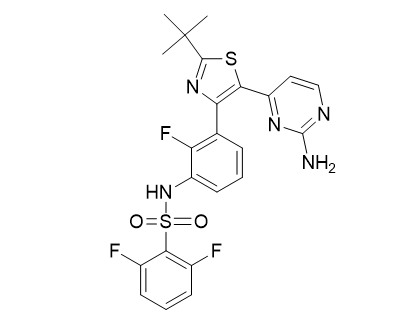Dabrafenib
Dabrafenib (GSK2118436) is a mutant BRAFV600 specific inhibitor with IC50 of 0.7 nM in cell-free assays, with 7- and 9-fold less potency against B-Raf(wt) and c-Raf, respectively.
Inquire / Order:
manager@chemfaces.com
Technical Inquiries:
service@chemfaces.com
Tel:
+86-27-84237783
Fax:
+86-27-84254680
Address:
1 Building, No. 83, CheCheng Rd., Wuhan Economic and Technological Development Zone, Wuhan, Hubei 430056, PRC
Providing storage is as stated on the product vial and the vial is kept tightly sealed, the product can be stored for up to
24 months(2-8C).
Wherever possible, you should prepare and use solutions on the same day. However, if you need to make up stock solutions in advance, we recommend that you store the solution as aliquots in tightly sealed vials at -20C. Generally, these will be useable for up to two weeks. Before use, and prior to opening the vial we recommend that you allow your product to equilibrate to room temperature for at least 1 hour.
Need more advice on solubility, usage and handling? Please email to: service@chemfaces.com
The packaging of the product may have turned upside down during transportation, resulting in the natural compounds adhering to the neck or cap of the vial. take the vial out of its packaging and gently shake to let the compounds fall to the bottom of the vial. for liquid products, centrifuge at 200-500 RPM to gather the liquid at the bottom of the vial. try to avoid loss or contamination during handling.
J Chromatogr A.2017, 1518:46-58
Korean Journal of Pharmacognosy2017, 48(4):320-328
Pharmacol Rep.2017, 69(6):1224-1231
Evidence-based Compl.&Alternative Med.2023, 5417813
J Inflamm Res.2022, 15:5347-5359.
Konkuk University2023, 29:4634721
J Cell Mol Med.2022, 26(23):5807-5819.
Molecules.2024, 29(5):1171.
Food Chem.2024, 446:138870.
Korean. J. Pestic. Sci.2024, 28(3):241-248.
Related and Featured Products
Mol Cancer Ther,Mol Cancer Ther.
Combinations of BRAF, MEK, and PI3K/mTOR inhibitors overcome acquired resistance to the BRAF inhibitor GSK2118436 dabrafenib, mediated by NRAS or MEK mutations.[Pubmed:
22389471]
Recent results from clinical trials with the BRAF inhibitors GSK2118436 (Dabrafenib) and PLX4032 (vemurafenib) have shown encouraging response rates; however, the duration of response has been limited.
METHODS AND RESULTS:
To identify determinants of acquired resistance to GSK2118436 and strategies to overcome the resistance, we isolated GSK2118436 drug-resistant clones from the A375 BRAF(V600E) and the YUSIT1 BRAF(V600K) melanoma cell lines. These clones also showed reduced sensitivity to the allosteric mitogen-activated protein/extracellular signal-regulated kinase (MEK) inhibitor GSK1120212 (trametinib). Genetic characterization of these clones identified an in-frame deletion in MEK1 (MEK1(K59del)) or NRAS mutation (NRAS(Q61K) and/or NRAS(A146T)) with and without MEK1(P387S) in the BRAF(V600E) background and NRAS(Q61K) in the BRAF(V600K) background. Stable knockdown of NRAS with short hairpin RNA partially restored GSK2118436 sensitivity in mutant NRAS clones, whereas expression of NRAS(Q61K) or NRAS(A146T) in the A375 parental cells decreased sensitivity to GSK2118436. Similarly, expression of MEK1(K59del), but not MEK1(P387S), decreased sensitivity of A375 cells to GSK2118436. The combination of GSK2118436 and GSK1120212 effectively inhibited cell growth, decreased ERK phosphorylation, decreased cyclin D1 protein, and increased p27(kip1) protein in the resistant clones. Moreover, the combination of GSK2118436 or GSK1120212 with the phosphoinositide 3-kinase/mTOR inhibitor GSK2126458 enhanced cell growth inhibition and decreased S6 ribosomal protein phosphorylation in these clones.
CONCLUSIONS:
Our results show that NRAS and/or MEK mutations contribute to BRAF inhibitor resistance in vitro, and the combination of GSK2118436 and GSK1120212 overcomes this resistance. In addition, these resistant clones respond to the combination of GSK2126458 with GSK2118436 or GSK1120212. Clinical trials are ongoing or planned to test these combinations.
Molecular Cancer Therapeutics 8(Supplement 1):B88-B88.
A selective Raf kinase inhibitor induces cell death and tumor regression of human cancer cell lines encoding B-RafV600E mutation.[Reference:
WebLink]
Activation of the Ras‐Raf‐MEK‐ERK pathway has been implicated in a large range of human cancers. Growth factor receptor stimulation by extracellular ligands activates Ras, which then sets in motion a signal transduction cascade through the Raf, MEK and ERK serine/threonine kinases. Mutation of the B‐Raf kinase constitutively activates MAPK signalling, thus bypassing the need for upstream stimuli. This has been genetically associated with several human cancers, especially occurrence of the B‐RafV600E mutant and its high prevalence in melanoma, colorectal carcinoma, ovarian cancer, papillary thyroid carcinoma, and cholangiocarcinoma. The ability to selectively and potently inhibit B‐Raf should provide a potential therapy for patients with mutant B‐Raf tumors, for which addictive dependency on this pathway is observed.
METHODS AND RESULTS:
We have identified a novel, potent, and selective Raf kinase inhibitor that is capable of inhibiting the kinase activity of wild‐type B‐Raf, B‐RafV600E and c‐Raf with IC50 values of 3.2, 0.8, and 5.0 nM, respectively. Kinase panel screening for over 270 kinases has indicated that this inhibitor is selective for Raf kinase, with ∼400 fold selectivity towards B‐Raf over 91% of the other kinases tested. Specific cellular inhibition of B‐RafV600E kinase by this inhibitor leads to decreased ERK phosphorylation and inhibition of cell proliferation by an initial arrest in the G1 phase of the cell cycle, followed by cell death. This inhibition is selective for cancer cells that specifically encode the mutation for B‐RafV600E.
CONCLUSIONS:
Oral compound administration inhibits the growth of B‐RafV600E mutant melanoma (A375P) and colon cancer (Colo205) human tumor xenografts, growing subcutaneously in immuno‐compromised mice. This cell‐specific B‐RafV600E inhibitor is currently being evaluated in a human Phase I clinical trial.
ACS Med Chem Lett,2013 Feb 7;4(3):358-62.
Discovery of Dabrafenib: A Selective Inhibitor of Raf Kinases with Antitumor Activity against B-Raf-Driven Tumors.[Pubmed:
24900673]
Hyperactive signaling of the MAP kinase pathway resulting from the constitutively active B-Raf(V600E) mutated enzyme has been observed in a number of human tumors, including melanomas.
METHODS AND RESULTS:
Herein we report the discovery and biological evaluation of GSK2118436, a selective inhibitor of Raf kinases with potent in vitro activity in oncogenic B-Raf-driven melanoma and colorectal carcinoma cells and robust in vivo antitumor and pharmacodynamic activity in mouse models of B-Raf(V600E) human melanoma.
CONCLUSIONS:
GSK2118436 was identified as a development candidate, and early clinical results have shown significant activity in patients with B-Raf mutant melanoma.



